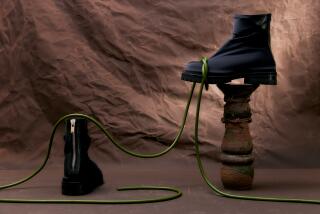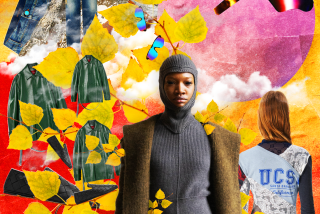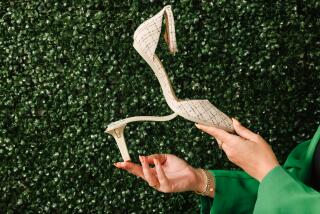On shoe shopping: Pay more, spend less
- Share via
KNEE-LENGTH in full-grain leather, the oxblood riding boots were so stiff, they stood on the shelf as straight as Redwood saplings. I lingered in front of them, admiring the softly rounded toes, not too pointy or blunt, that capped off the shapely foot bed and the thin strap that encircled the vamp, anchored by a subtle brass buckle.
Classic and pragmatic, they were the kind of boots you spot on the quietly wealthy -- women who eschew brand logos and obvious bling. Costume National, the avant-garde Italian brand, made them. And I wasn’t leaving the store without them.
Trouble was, I was far from wealthy -- quietly or otherwise -- and the objects of my desire were $700. On sale. It was 2003, and I was working as a mid-level editor at a magazine and shouldering a mountain of grad school debt. I was in no position to buy a $700 anything. Especially when it was a struggle to find $800 for rent. But urged on by a friend, I pulled the trigger, nearly choking on my recklessness as I handed over a new Visa in payment. I’d never have guessed that the purchase would forever change the way I shop.
I’d always been a chronic shoe shopper -- an impulse buyer who splurged on three to four new pairs of moderately priced shoes every season. But as I pulled on those boots month after month, I was amazed at how fantastic they continued to look and feel. Price doesn’t always dictate quality and comfort (I have a pair of $500 stilettos that hurt even to look at), but after years of abuse, my feet were thanking me for pouring them into something so well-made. And they didn’t want to go back to throw-away shoes.
Four years later, the boots are still in regular rotation in my wardrobe. More comfy than a pair of Asics, they’ve taken long, exploratory walks through St. Petersburg, Amsterdam, Tallinn and Rome -- and through countless L.A. ‘hoods. Not only have they held up fantastically (the heel shows some minor wear, but the hand-nailed rubber sole is still near-pristine), but they’re even more handsome now, with nicks and scratches adding gorgeous dimension to the cognac leather.
That first pricey pair proved to be my gateway drug to high-end footwear, which might have proved disastrous. But once I went high-end, I found I was buying significantly less, because I was happily wearing each pair more frequently. Cravings for new styles started to subside. And within six months, my pattern of overspending on the cheap stuff was officially broken.
By my calculations, spending more actually saved me money. (An estimate: I used to buy three pairs of shoes every season -- that’s 12 pairs at $125 each, about $1,500 annually. Now I buy three to four pairs a year -- each priced between $200 and $400 -- roughly totaling $1,100.)
It takes some strategy. The concept of paying more to save more requires you to leave “it” shoes on the shelf. Investing in shoes that are splashed all over the fashion mags and blogs each season is verboten if you’re on a budget (and I definitely still am). Prada’s ruffle-heeled shoes for fall are drool-worthy, for example, but they’re getting too much press to look fresh a year from now.
And you don’t have to pay full price for designer shoes -- I never do. I shop BlueFly.com, Barneys New York warehouse sale in Santa Monica and end-of-season sales at boutiques such as Madison Los Angeles and Fred Segal Feet. Local outlets can be gold mines too. Early this year, I snapped up a pair of Yves Saint Laurent heels for $120 at the brand’s store at Desert Hills Premium Outlets. Who cares if they’re past season? They’re stunning and not so trendy that most people can fix them to a certain season -- exactly what you’re looking for.
At this price point, think in years, not seasons. It will be eons before you discard a pair of Chanel flats, black Christian Louboutin heels or Burberry riding boots. Dropping a car payment on a pair of platforms never felt so frugal.
More to Read
Sign up for The Wild
We’ll help you find the best places to hike, bike and run, as well as the perfect silent spots for meditation and yoga.
You may occasionally receive promotional content from the Los Angeles Times.










